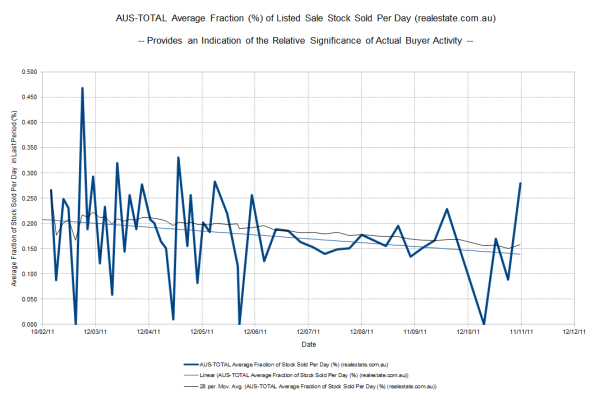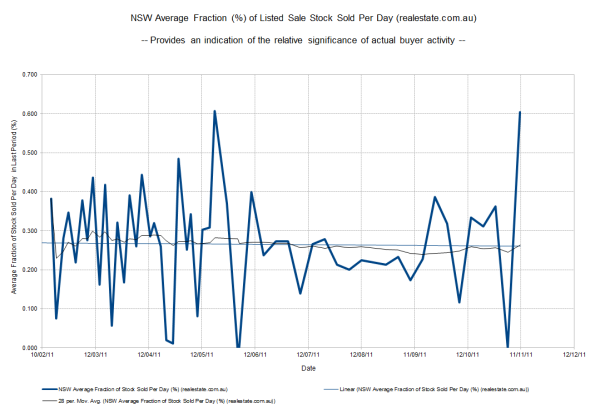Follow up to my last post: The recent Australian sales surge, and the NSW factor
I wrote a “quick” reply to a visitor name “TM”, who responded to my last post, “Australia: New Phase? Rental Listings Acceleration“.
I suggested that interpreting the significance or not of a rental surge should be understood within context – particularly, the medium-term listings trend, and the sales trends; seasonality is also a very significant factor, and I would suggest it plays a major part in what is occurring…perhaps even the major part at this point in time.
As many know, property is a slow, lumbering, illiquid market, and it is, honestly quite difficult to know what a movement in a parameter or two really means until a good 6 months or so has passed.
I promised some more context, so here is some updated data for Australia.
Australian Relative Sales Trend
(realestate.com.au – Fraction of listed stock sold (%), expressed as a daily figure…in my opinion this notion gives a better idea of the relative significance of property sales, as it adjusts for the amount of stock on the market at the time…absolute/raw sales figures are misleading)
As you can readily observe, the general trend of the last 12 months has been for the relative significance of property sales (ie. sales compared to stock on market) to decrease almost continually with time. However, I do find it very interesting that the most recent data show a spike in relative significance – ie. since the Reserve Bank of Australia (RBA) dropped interest rates.
I would be fairly confident asserting that this interest rate drop (though only 0.25%), combined with on-going price reductions, has lead to a surge in sales in very recent times. Most states showed a jump in relative sales significance in the last week since the RBA decision, but all but NSW actually only had minor increases; NSW, on other hand, recorded quite a major surge, and it is a major contributor to the overall Australian trend – and, therefore, would explain the majority of the Australian surge:
Another parameter to consider for NSW is the “Buyer Price Reduction Responsivity Index” – that’s a fancy name for getting an idea of how much price reductions in listed (Vendor) sales prices might be affecting the demand/desire to purchase a property.
The chart for NSW is here:
That’s quite a jump! And a good indication for those who want to sell their properties in NSW – price reductions are working very well in recent times!
That is, this chart suggests that there has been a consistent improvement in the Deflationary Mindset of buyers since this BurbWatch index has been going (since early Feb 2011) – ie. this index suggests, via correlative (not necessarily causative) methods that buyers are responding better and better to reductions in the Vendor/asking price.
Otherwise expressed, buyers are not yet indicating they have what is a “Deflationary Mindset”, as mentioned above.
As I define it, a Deflationary Mindset is an expectation that prices will continue to drop and, as such, buyers may hold off their purchases – this does not seem to be the case for buyers of NSW properties at this point in time (which contrasts markedly to what I have heard about buyers in, say, many states of the USA, where holding off to make a purchase upon the expectation that “it will be cheaper next month”, certainly seems to have take hold. Why purchase now when it will be cheaper, later, they ask themselves?)
So, whilst Deflationary Mindset has not taken hold in NSW, it does, however, seem that the average Vendor is needing to reduce the asking price of their property in order to move it: compare the Responsivity trend in the above chart, with the following Price Reduction Density Index chart for NSW (where the “Price Reduction Density Index” simply gives an idea of the quantity of Vendor price reductions that are occurring per unit of listed sales stock – it is an indication of relative Vendor price stress, or Vendor price pressure concentration):
Together, the previous two charts show us a better picture:
- Buyers are responding better and better to Vendor Price reductions
- But the average Vendor is finding that they are having to reduce their property more frequently than they used to, in order to “meet the buyer/market”
Hopefully this helps to put the NSW purchase surge into some extra context, and by doing so, put the recent surge in Australian sales into context also. Sure, it is only recent data…I wonder what will be revealed in the coming weeks?
Regards,
Stewart




Thank you!